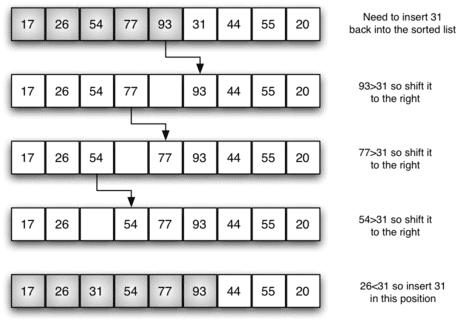Many different insertion sorting algorithms are the most common, but this is the most common. More complex algorithms like quicksort, heapsort, and merge sort are substantially more efficient on huge lists. Every input element is consumed in every iteration, and the resulting output list is sorted. A single element from input data is removed with each iteration of insertion sort, and a new element is found and inserted into the sorted list in its proper place. It keeps repeating itself until there are no more inputs.
The array is often iterated through sorting, resulting in an ever-growing sorted list. It compares each array-value position to the sorted list’s most excellent value at each array position. If it is more significant, it continues to the next element. Smaller values are inserted into the sorted list, while bigger ones are shifted to accommodate the new value. After k iterations, the first k+1 elements are sorted in the final array. Remove the first leftover input entry and insert it into the output at the right point in each iteration. We will cover everything related to the Insertion Sort Stable in this post.
Sorting is stable if it preserves the relative order of equal elements!
Is Insertion Sort Stable?
The insertion sort is stable because it preserves the relative order of equal elements and builds the final sorted array one item at a time. Stable sorting algorithms include Bubble Sort, Insertion Sort, Merge Sort, and Count Sort.

Examples of these algorithms include If, and only if-Element A [j] arrives before A [i] in Merge Sort & Insertion Sort; stability is maintained by guaranteeing that Element A [j] occurs before A [i]. If A [i] equals A [j] and if A [i] occurs before A [j], the relative sequence is preserved. The sorted array is populated in reverse order, so elements with comparable keys have the same relative position in all non-comparison-oriented sorts, like the Counting Sort. Radix Sort, for example, relies on another sort that must be stable to work.
The stability of sorting algorithms such as Quick Sort, Heap Sort, and others can be improved by considering the components’ positions. It is possible to make this adjustment using a method that does not significantly impact performance and requires additional storage space. In addition, it is possible to modify any sorting algorithm that is not stable to be stable. For example, if a sorting algorithm’s comparison operation doesn’t consider object location for items with equal keys, it can be updated to make it more stable. By altering the comparison operation, sorting algorithms that aren’t naturally stable could be more stable.
What is the relationship between insertion sort and selection sort?
Both the insertion sort and the selection sort are similar. In the selection sort, after the K passes over the array, the first k elements are sorted in order.
As the name suggests, insertion sort searches in reverse order, whereas selection sort scans in the opposite direction from the current key. The first k elements of an unsorted input are the k most minor items in a selection sort, but the first k elements are just the first k elements in an insertion sort. Insertion sort has an essential benefit since it only has to compare the (k + 1)-st element to the kth element whenever the (k + 1)-st element is higher than the kth element. It is usually the case that insertion sort is significantly more efficient than selection sort. Furthermore, insertion sort requires comparing and moving half of the previous k elements on average (assuming the rank of (k + 1)-st element rank is random), suggesting that insertion sort performs roughly half as many comparisons as selection sort overall average.
Selection sort performs as many comparisons as insertion sort if the input array is sorted in reverse order. Insertion sort indeed requires more writes than selection sort, but inserting the (k + 1)th element into the sorted portion of an array requires several more element swaps to shift all of the following aspects. However, only a potential single swap is necessary for the selection sort on each iteration. While the insertion sort writes to the array O (n2) times, the selection sort writes just O (n). Selecting sort may be desirable when writing to potential memory, but it is much more expensive than reading, as with EEPROM.
Conclusion
Since we have key-value pairs with the possibility of duplicate keys, stability is very crucial. Therefore, these items will be sorted alphabetically by key. Stability isn’t a concern when the whole element is the key, as it is with integers or other data types where equal elements are indistinguishable. Likewise, stability is not a problem if all the keys are different.
Insertion sort and selection sort are incredibly similar. In the same way that selection sort works, the first k members of the array are sorted after k passes over it. While both algorithms work by scanning from the current key backward, the significant distinction is that insertion sort works in reverse. The first k elements of an unsorted input are the k most miniature items in a selection sort, but the first k elements are just the first k elements in an insertion sort. We hope you have understood whether The Insertion Sort Stable is correct.
- Facebook Ads to Get Followers! - December 27, 2024
- ClickUp vs. Slack - December 20, 2024
- Mastering E-Commerce Analytics: A Blueprint for Success




